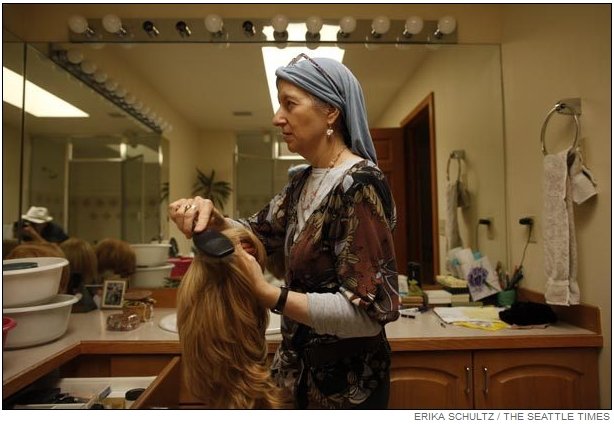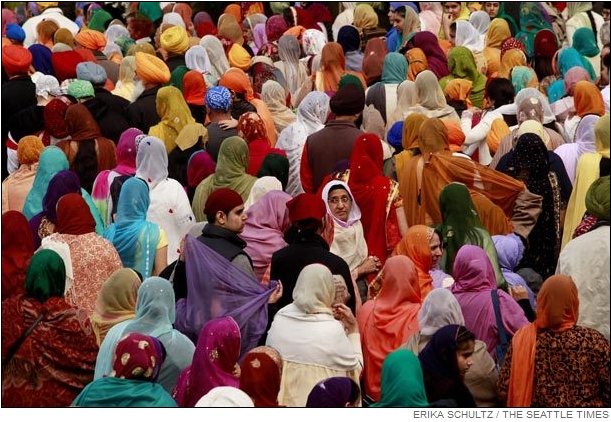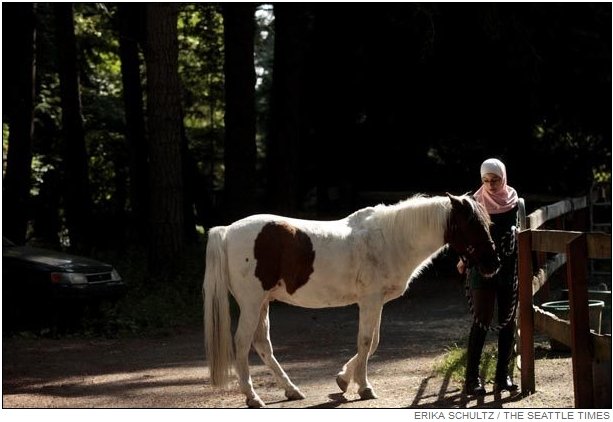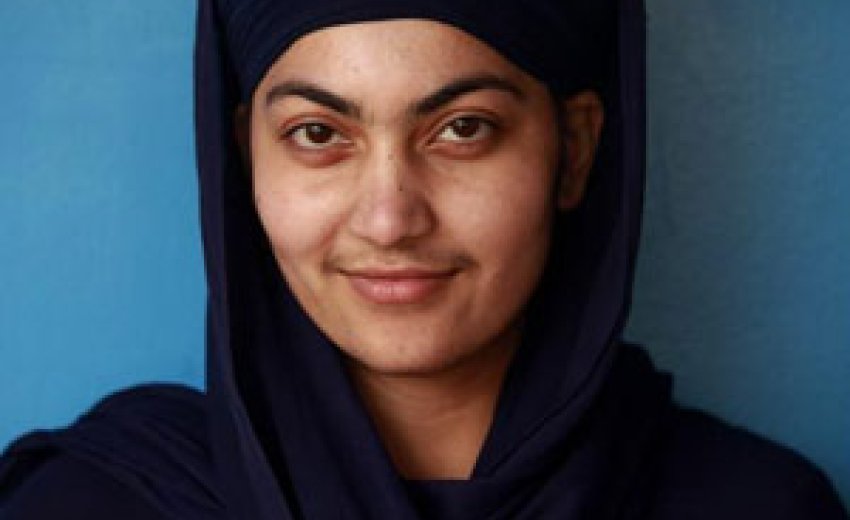 |
| ERIKA SCHULTZ / THE SEATTLE TIMES Inderpal Kaur, 21, wears a turban primarily to be identified as Sikh. |
Though of different faiths, Seattle-area women who wear scarves, wigs, hats or turbans over their hair say the practice makes them feel connected to their faith, yes, but also protected and valued.
TZIVIAH GOLDBERG eases into the stylist's chair at Essence Salon in Seattle's Maple Leaf neighborhood, the mirror before her reflecting the image of a woman conservatively dressed: long, flowing skirt, sleeves to her wrist.
The stylist adjusts the wig on Goldberg's head and passes a curling iron through the blonde hair to give it lift.
The wig, too, is part of Goldberg's conservative look.
Orthodox Jewish laws obligate married women, for the sake of modesty, to cover their hair — considered part of a woman's sensual beauty to be shared only with her husband.
An Hasidic Jew and mother of 10, Goldberg wears only wigs when in public, although some Orthodox Jewish women also wear hats and scarves — part of a sisterhood that, while rooted in religion, transcends the boundaries of religion.
Though of different faiths, Seattle-area women who wear scarves, wigs, hats or turbans over their hair say the practice makes them feel connected to their faith, yes, but also protected and valued.
"Jewish or Muslim or Christian, this is all about respecting women, no matter what religion it comes through," Goldberg says. "It shows respect for women if they aren't just out there hanging out for everyone to see ... and I think it's great that Muslim women cover as they do."
For many it's also a practice steeped in their culture or part of long-standing traditions they are proud of.
Deshraelle Diallo, a 16-year-old Ballard High School student who is Christian and wrestling with whether to convert to Islam, says she covers her hair out of deference to her mother, who is Muslim.
And 21-year-old Inderpal Kaur of Burien, a student at Highline Community College, wears a turban over hers because it identifies her as Sikh.
But in American society, where women don't traditionally cover their hair, those who do often stand out, whether in the workplace, at school, at the grocery store or on the street.
In the years since the terrorist attacks of Sept. 11, 2001, brought Islam more overtly to the attention of the Western world, head covering has become more polarizing — especially for Muslims.
In some European countries, religious head and face coverings have been banned in public schools and government buildings.
Locally, some Muslim women speak of awkward stares or outright insults from strangers: References to Osama bin Laden are common, as are refrains of "go back where you came from."
Immigrant or native born, they say there appears to be an assumption that women who cover are perpetual foreigners, unable to speak or understand English.
One young kindergarten teacher who wears the niqab, a face veil that leaves only the eyes exposed, said a bus driver once refused to allow her to board, telling her to "remove that thing from your face," and asking repeatedly, "Who are you hiding from?"
Others say they are often accused of being controlled — persecuted, even — by male-dominated societies intent on keeping women in their place.
In some Middle Eastern countries, and in some Western communities, women are beaten — some have been killed — for not covering their hair in public.
But around here, where women typically make the choice, they prefer to focus on what a good thing it is for them. It's why many say they don't mind the hassles and questions — that as insensitive as they can sometimes be, they open far more doors than they close in dispelling myths around their cultures and religions.
"I have far more interactions with people because I'm covered," says Aliah Haji, 23, the teacher who wasn't allowed to board the bus.
"People approach me wanting to know. I have an opportunity to tell them about Islam."
VEILING HAS ROOTS much deeper than the three Abrahamic faiths — Christianity, Judaism and Islam — back to the Ancient Near East, thousands of years before the Christian era, when only women of privilege were permitted to cover their hair.
"It signified a division of women based on being respectable, that these were not women available to others," says Nayereh Tohidi, a professor of gender and women's studies at California State University in Northridge.
"From there, it expanded across the world."
Referenced in one form or another in religious texts, the practice was later adopted by the Abrahamic faiths — and over the centuries, it evolved.
Within Christianity, head covering has been mostly lost. By the turn of the 20th century, at least in the U.S., scarves had given way to stylish and more fashionable hats worn in church, until eventually that practice also mostly disappeared.
Even many nuns who used to wear veils no longer do, Tohidi says. Some Catholics and other Christians may choose to put something over their hair when they go to church, she says. And Catholic girls receiving First Communion still wear veils, as do many brides, no matter their religious affiliation.
In a few ultraconservative Christian sects, such as Mennonites and Amish, as well as among some Orthodox churches, women regularly cover in public.
But even among scholars and religious leaders who share a faith — and within all three major religions — the ways and reasons for covering remain in debate.
Within Orthodox Judaism, for example, some question the wig as appropriate head covering because, to the naked eye, it appears no different from real hair.
Goldberg sees it differently: "If you wore a super fancy wig that wouldn't be modest, because it's like saying, 'Look at me, look at me.' "
When she married 28 years ago, she chose a wig — close in color to her own hair — because it allows her to cover her hair more completely than she can with a scarf. She also recognized that it requires far less explanation in public than a scarf or hat would.
 |
| Tziviah Goldberg, an Hasidic Jew, wears a wig over her natural hair while out in public and a snood at home, as she does here. "Covering my hair allows me to follow our sacred Jewish traditions, which respect the modesty of married women," she says. "Modesty isn't just covering your hair or what you wear. It's a mindset. The hair covering is just part of the whole picture of faith." |
Goldberg explains that "the idea is not to look ugly, frumpy or unattractive. You can look very stylish as long as it's not, 'Wow look at me. I'm wearing everything completely covered, but it's skin tight.' "
Raised mostly Christian, the 54-year-old Goldberg converted to Judaism while in law school. Her Jewish husband, who was not overly observant when they met, was not fully onboard with her covering her hair with a wig, she recalls. So they traveled together to New York where she tried on several before settling on one he felt comfortable with.
"The bottom line is if you're an observant Jew, you do things because God said that's what a Jew does," Goldberg says.
"But it doesn't mean you have to do it in a way that makes you miserable. You do it with joy and acceptance, and because you want a relationship with God."
 |
| Inderpal Kaur, 21, wears a turban every day to show her spiritual devotion and to identify herself as a Sikh. Kaur can put on her turban in about 5 minutes, she says, "Unless I am having a bad turban day." |
ON A MILD day this summer, before rushing out the door of her Burien home to get to her job at UPS, Inderpal Kaur checks to make sure the black turban wrapped on her head is firmly in place.
Some baptized Sikh women, like men, wrap their hair in turbans when in public, while others like Kaur's mother, Satvir, wear a headscarf, called a chuni.
While people can be born Sikh (pronounced like "sick"), it is only through baptism that they truly become observant followers of the religion. An only child, Kaur says, "my parents encouraged but never forced me. All they said is 'pray once in a while.' This was my decision. I made this choice."
A computer-science student at Highline, Kaur was baptized five years ago after attending a faith camp in California and just before starting high school.
"I was very nervous; not sure if my friends would accept me this way," she says. "But my dad told me, 'You stepped into this path and you have to put your trust in God. He won't let you down. Don't worry about it.' "
Strict adherence to Sikhism requires steadfast commitment to five principles — the requirements for women generally the same as for men.
Observant Sikhs may not cut their hair and must wear a wooden comb in it at all times. They are required to wear special underwear, a metal bracelet on their wrist as a reminder always to do good and a 6-to-9-inch-long curved dagger they must carry at all times to come to the aid of someone in trouble.
Kaur says she sometimes wears the sword in her hip-length hair as opposed to on her body, in part to avoid "freaking people out."
 |
| Thousands walk in Renton's Khalsa Day parade. Sikh men and some women cover their hair as part of their identity. Women also wear long headscarves called dupattas at religious ceremonies to show respect. |
For Sikh women who choose to cover — Sikhism doesn't strictly require them to — the purpose is not modesty but rather to identify them as Sikh, to keep their hair clean and as a constant reminder to do good.
"I get up, get dressed, and put on my turban and I feel good. This is who I am," Kaur says.
Many baptized women of her faith don't cover their hair because "I guess it's not considered fashionable," she says.
"Most women just want to fit in; they want to look pretty so they put their hair down, they wear fancy little clips. But I feel I have to stand out for my religion. I don't think there's any shame in it. Wearing a turban does not make you less of a woman."
PERHAPS NO religion is as intuitively associated with head covering as Islam. While not all Muslim women cover their hair, veiling is more prolific among them than among any other religious group of women these days.
Still, inside and outside the religion, there's debate about the political implications of headcovering and whether the Quran specifically requires it.
The sole reference is to a passage that urges a woman to draw her veil over her bosom. Most Islamic scholars say the presumption is that the veil is already covering the hair.
But Tohidi, the California professor, doesn't see it the same way, saying that something so important in the lives of Muslims would surely have been specifically cited — the way violations such as alcohol use and the taking or granting of credit are.
Also, she says, there's no specific punishment in the Quran for not covering like there is for other acts considered to be transgressions.
But any discrepancy in interpretation is lost on those women who do wear the hijab, and who say they do so because they believe, as pious, religious women, it is what is required of them.
 |
| During her riding lessons at Brackenhollow Stables, Heba Bakhach, 25, wears a loosefitting shirt, riding pants and hijab instead of her regular jilbab, or long dress. To preserve her modesty, she works with a female instructor in a private setting. |
For Heba Bakhach, 25, the daughter of a Lebanese father and a Nicaraguan mother, it was never a question.
Born in Saudi Arabia, Bakhach and her family moved to Toronto when she was 9, and after high school returned to the Middle East, where she attended college in Lebanon.
She began covering her hair in Saudi Arabia, the way most females there do once they reach puberty. Comfortable clothing has always been part of her natural style, but in Toronto, she was shocked by her father's sudden demand that she begin wearing the jilbab — a loosefitting garment that covers a Muslim woman from neck to ankles.
Bakhach was 16 at the time, and on the girls soccer team, wearing long pants and long-sleeve jerseys to maintain modesty.
"My father was of the opinion I had to wear that dress."
"I was pretty upset for a few years," she says.
A teacher later explained the garment's religious significance to her, and she now wears it all the time.
Except on this June afternoon after a horseback-riding session in Redmond when Bakhach is wearing her riding breeches, a white head scarf framing her pretty face.
Co-workers at the pharmacy where she works in Mount Vernon never ask about her conservative dress, but customers sometimes do: "What's that thing on your head?" some have asked her.
"For many of them I guess it's the first time in their lives seeing a Muslim," she says. "They'd say: 'I saw people like you on TV. Eeeeslam?' "
She also acknowledges that in some cultures a female who fails to cover "could bring shame on the family," which might even disown her. She remembers the Mutaween, Saudi Arabia's religious police, patrolling the streets, looking for violators of Islam's rules. But it's not something she thinks of all the time. "It's just a fact of life," she says.
For her, covering is about a commitment to her faith.
"I know I'm pleasing God when I do it; that's the core reason."
EVEN AMONG women who cover their hair, the niqab, a cloth that cloaks the lower part of the face to leave only the eyes exposed, is controversial — at least in this country.
The cloth, worn by the wives of the Prophet Muhammad, is rarely used among Muslims in the U.S. The Quran does not specifically mention it.
But a local group of young Muslim women and friends, all in their 20s, wear it as part of their all-black, conservative attire, what they call their uniform.
They say they first began wearing the niqab to see if they could — and now remove it in public only to take their driver's-license photos and lift it when they eat out.
The women share a special bond; they play tennis together and jokingly question each other about how they will find a husband with their faces concealed.
One of them, Aisha Sharif, 22, says her parents flatly refused to let her wear the niqab when she was still in high school. None of her six older sisters do.
She had researched the niqab carefully and wanted to wear it as a way to emulate the righteous women of the Quran.
But her concerned parents had questions: They said, "How are you going to get a job when you graduate? What if someone physically assaults you?"
Originally from Somalia, Sharif says she couldn't wait to graduate from high school.
"For me, it was embracing my religion, my identity: how I am to be as a Muslim woman," she says. "I had to be comfortable with myself."
In Western society, she says, "everything now is about a woman's beauty — you know, her hips, her curves, her face, her hair."
Sharif says she believes beauty lies within, and she dismisses the idea that she needs "to sway her hips to get a man's attention." She wants to gain people's respect — including men's — for the kind of person she is, not what she looks like.
"I don't have to worry about what society will think about my appearance," she says. "All I worry about is what God will think about me, my heart and my actions. When I dress and walk out, I'm a Muslim. That's the image that people see."
For more photos with head coverings please click here
Lornet Turnbull is a Seattle Times staff reporter. She can be reached at 206-464-2420 or [email protected]. On Twitter @turnbullL.
